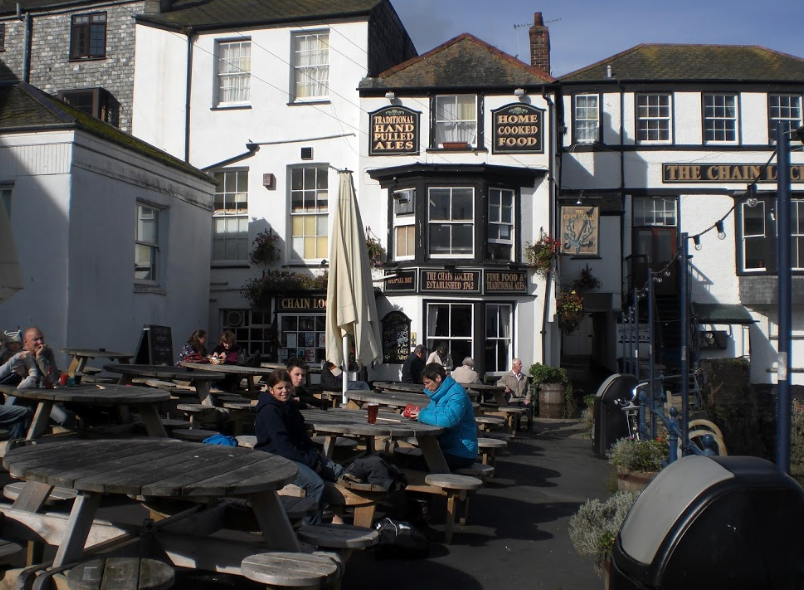The Chain Locker Pub: Uncovering the past
Falmouth’s iconic pub takes its name from the grimiest place on the ship. Despite its recent refurb, the Chain Locker’s gritty past can be witnessed through the clues once hidden in its walls.
The Chain Locker pub frames Custom House Quay on its western side. Its broad back lies on Quay street, a narrow street leading down to the water. The lack of space means that you must crane your next to take in the pub’s listed façade. A passageway links the street and the quay, taking you from the cramped street to the open space of the quay itself.
The pub has recently undergone a six-figure refurbishment undertaken by St Austell Brewery. The Brewery’s Chris Knight explained that they expected to make significant repairs to the fabric of the building, but had not bargained on the extent of restoration needed, nor the rich finds hidden within its walls and floors.
It was only when the Brewery called time for the two-year refurbishment that the team could assess the work ahead. The first task was to catalogue, with archaeological exactitude, the impressive array of nautical artefacts that adorned the pub’s walls. This was so that Falmouth’s beloved pub would look and feel the same after its restoration, illustrating the care that the team at St Austell Brewery took in taking on the custodianship of The Chain Locker.
During the first part of the restoration, the air in The Chain Locker was filled with dust and debris as the layers of patched and bodged repairs were excavated. There was no Moaning Myrtle found in the spaghetti of redundant pipework, but rather unexpectedly, a bread oven, now opened out as a welcoming fireplace in the downstairs bar.
“With the sea come sailors, and their stories and the walls have also absorbed the sounds and voices of the busy bar—voices that have changed with the passing of time.”
Behind the modern plaster, the walls gave the archaeological story of their ramshackle origins, of earth-core rubble stone construction, with some sections of wall bonded by plaster of earth and hair. With a lack of foundations (true of many old Cornish buildings), and the walls untethered to the neighbouring building, it seems remarkable that the wall along Quay Street, the backbone of the pub, remained standing at all.
It is not only the bricks and mortar that make The Chain Locker what it is, but also its impressive heritage. The pub has witnessed a great deal through different incarnations, its gaze always firmly on the harbour where much of its trade has come from. With the sea come sailors, and their stories and the walls have also absorbed the sounds and voices of the busy bar--voices that have changed with the passing of time.
The pub first opened its doors in the 1660s, then as The Maritime Hotel, with its back to the newly opened prison on the opposite side of Quay Street. Perhaps the walls first grew a little weary in those early days, when arguments between visitors spilled out from the prisons after visiting time. Perhaps the walls grew heavier because of some of the grime that fell from the labourers working on the coal schooners and coal carts - they came in for their wages in a small room on the seaward side, now part of the public bar. One can only imagine that coin collected went only as far as the bar for some of the workers.
“Shanties are still part of the Chain Locker’s culture today.”
As Falmouth grew as a maritime centre in the age of sail, and then steam, the sailors voices thick with drink, poured out their stories, stories that doubtlessly grew taller for the extra nip of rum. Captains of ships and their crews, dock-workers, lifeboat men, salvage tug masters all came for the good ales, banter, and shanties. The dockyard still brings customers in, but the clientele is broader these days. Shanties are still part of the Chain Locker’s culture today--particularly when the Falmouth Working Boat crews come back from racing.
Perhaps the most remarkable thing to be uncovered during the restoration is a section of delicate hand-painted wallpaper. The repeated design on this fragile paper--a blush pink background, with a texture like drying plaster, and large heads of white blossom--is thought to date back to the 17th century. Knight has sent a sample of the original wallpaper to The British Museum for analysis, and is still waiting on its results.
Various artefacts are on display, the wallpaper among them, though if you're looking for it, this is not downstairs with its nautical relations but rather has been framed on the wall upstairs, left intact.
The Chain Locker has always been a vibrant pub in the heart of Falmouth. It is well worth a visit, not just for the ale and chat, but also to marvel at the remarkable building and its place in the history of our town.
by Julia Webb-Harvey





